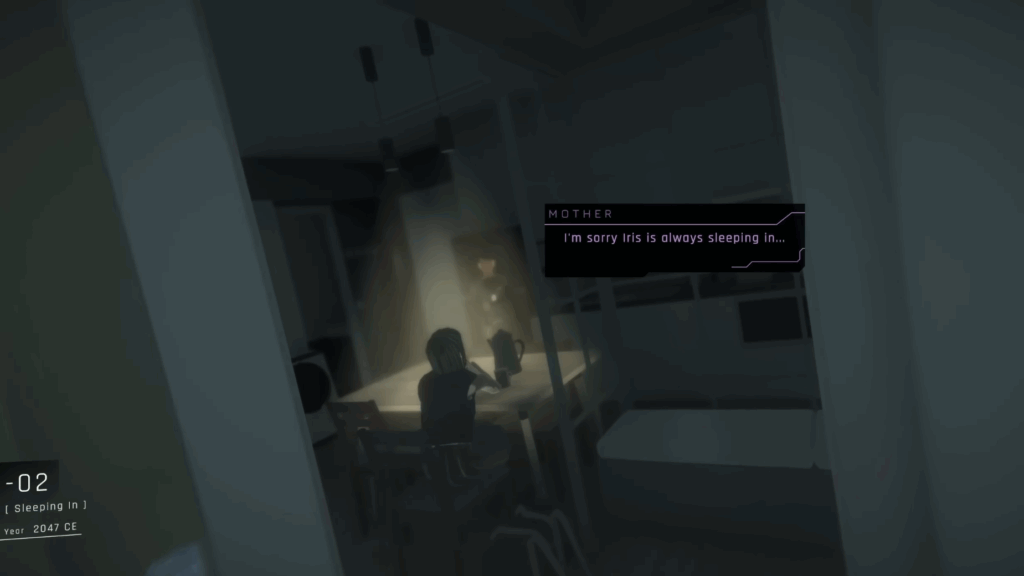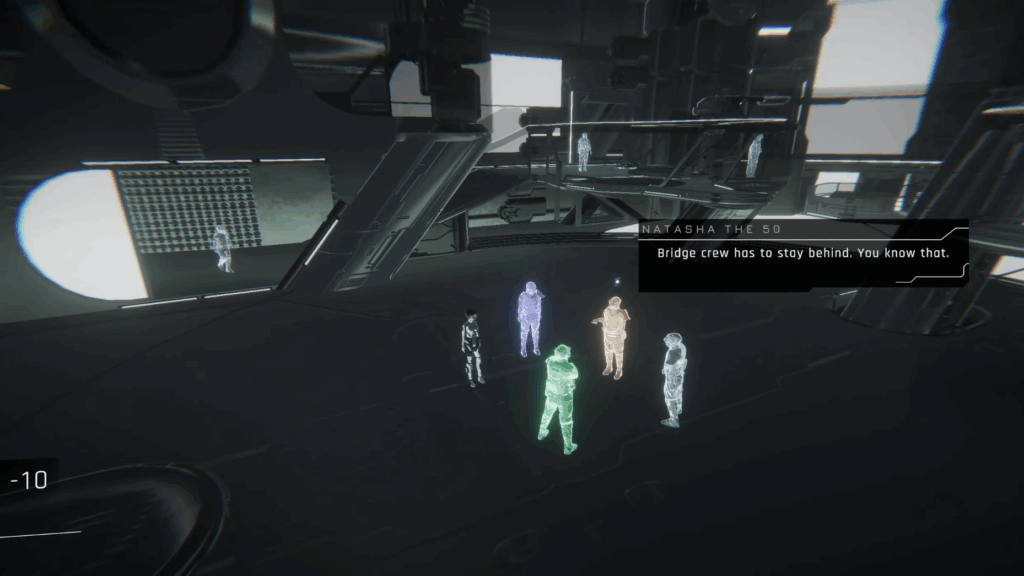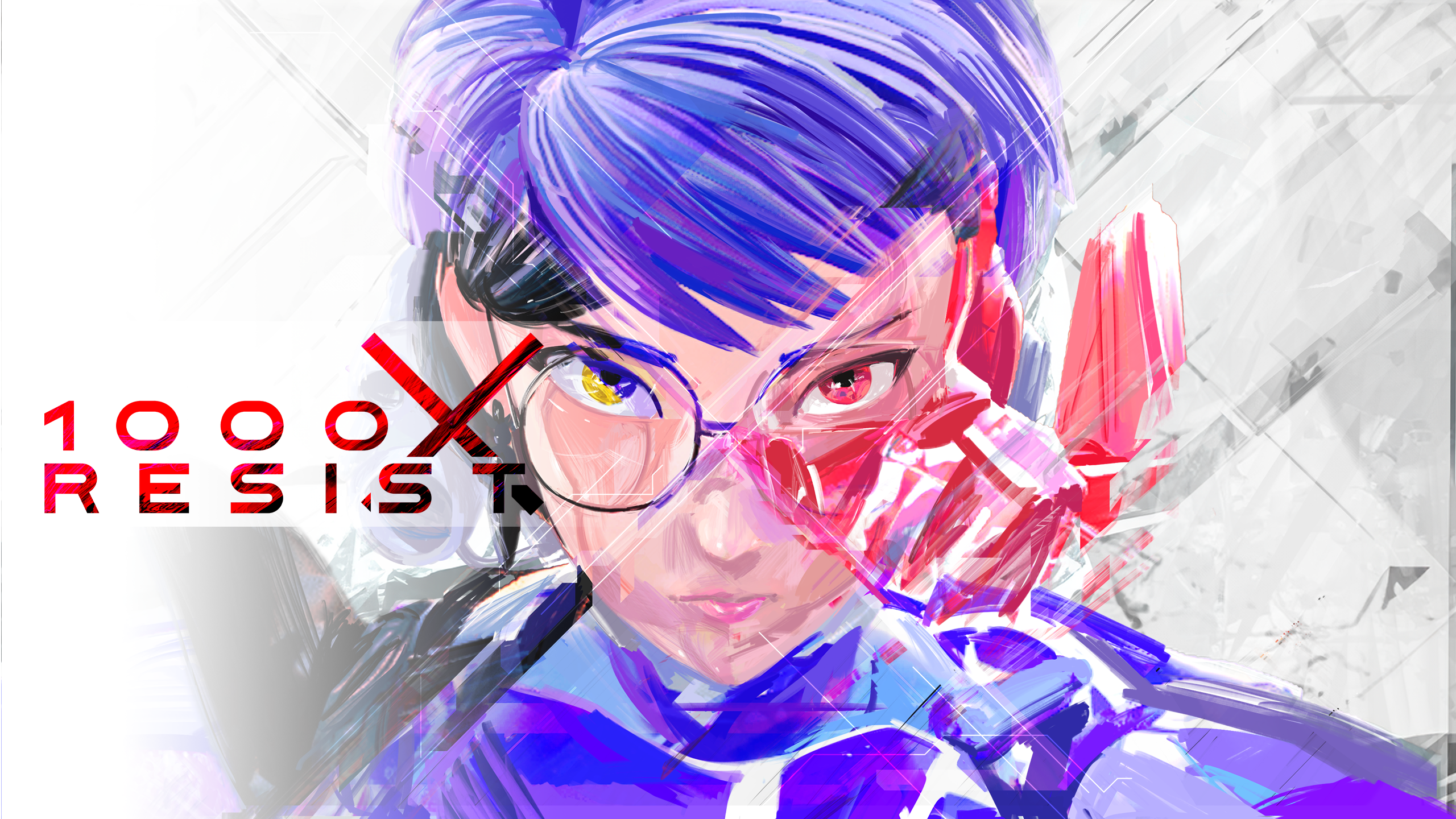1000xResist is a 2024 game made by sunset visitor and published by Fellow Traveller. It is a narrative focused sci-fi game centred around a future community of clones that worship the ALLMOTHER. It touches on many things like memory, resistance, and the self. The writing for all of this is incredible, but what I love even more is how the mechanics of the game are used to enhance all these themes. After setting up the core mechanics of the game, sunset visitor then uses slight but effective changes to this base to accomplish this. From a change in perspective to a change in presentation, and even just recontextualising the mechanics late in the game, 1000xResist can take advantage of what video games are as a medium to make it stand out even more than it already does.
The core mechanics and how you interact with the game are set up in the first chapter. The perspective is in a third-person, over-the-shoulder view set in the Orchard, a community of clones of the ALLMOTHER. Within this community, there are six core sisters that have leading roles: Fixer, BBF, Knower, Healer, Principal, and Watcher. Each looks after a certain function of the Orchard with the player being in control of Watcher.
As a part of Watcher’s role in the Orchard, she must carry out communions of the ALLMOTHER’s memories. A communion is the process of connecting to the ALLMOTHER’s memories and experiencing them as her with people in the memory seeing you as her. Beyond this, you can control the memory somewhat by switching between time indices. This changes the moment in time of the memory keeping the space the same but altering its contents to the new period allowing you to solve puzzles, explore the same space over time, and more.
Chapter 2 – New Perspective
After chapter one sets the basic gameplay mechanics up, chapter two starts to alter them to enhance the narrative and themes this new chapter is going for. In this communion, the camera is in first-person giving a much more intimate experience of events as now you are seeing directly through the eyes of Iris. It also works as a way of more directly experiencing Iris’ past more directly by having you see the events as you would in real life. This is integral to the chapter, being a recollection of Iris’ childhood, relationship with her parents, and decision to leave.
One repeated moment that occurs throughout this chapter is indicative of how much the change into first person is. At many moments, you (as Watcher (as Iris)) listen in on conversations through closed, or mostly closed, doors that you are not meant to be a part of. Doing this you listen to your parents concernedly discuss things that you have done with an amount of shock and confusion, hear your mother talk with Iris’ closest friend Jiao in a completely different manner than with you, and plenty more. Listening in on something you are not meant to like this just wouldn’t be as effective in third-person as you are removed from the character you are playing and are just watching Watcher/Iris listen in. The first-person perspective changes this so now it is you listening in, placing you in a completely different situation and aligns you with Iris which more effectively enhances our understanding of Iris’ character, and therefore our perspective on why she is leaving.

Peeking through a mostly closed door to listen in on a conversation between Iris’ mother and Jiao
This first-person perspective also changes your understanding of the space you occupy in this case it is Iris’ childhood home with moments ranging from when they first move in up until Iris leaves. Compared to a third-person view of a space where you can see large amounts of a level at a time, first-person requires you to engage with it within the confines of the character’s eyes and position. This requires a different understanding of the space and to explore it in a way more familiar to real life creating a connection to the space that would not be possible otherwise. This also makes interaction and reaction with the world different. For example, there is a moment where you are having a birthday party and talking to Jiao when she asks about when your other friends are going to show up. To confirm that none of them are here, you need to actively look around the room whereas in third-person, you would be able to see the entire room at once. This little thing makes the moment more impactful as it requires you to embody the act of shame that comes from none of your friends showing up. And together, this gives you a closer understanding of what Iris is going through in these moments.
Chapter 3 – New Presentation
Chapter three plays with the mechanics by having a fixed camera on what can be called the fourth wall. This follows the player left and right as they move but is at a fixed height and does not move closer at any point. Due to the space being consistent as you switch time indices it has the appearance of a stage-play. It also presents the story of this chapter through floating text in the style of a storybook. Combining these two changes gives the feeling of a fairy tale being told to us and is how the third chapter enhances itself.

Floating text presents the story beats similar in style of a storybook
There are two parts to this tale beginning with a continuation of the previous chapter’s communion with Iris leaving home and leading into an origin of her as the ALLMOTHER. However, the second part is what I will focus on here with Iris, now the ALLMOTHER, creating five clones of herself as her children. Upon their creation she gives them only one rule, to not create another sister as the power of creation belongs to her alone. “No sisters we make, no promise we break. Pluck hair from our heads, so slain us deads”. We then focus on one of these sisters known as The Youngest. Given the power of observation she is shunned by the other sisters for having a power that has no use compared to those of healing, fixing, defending, and knowing as well as being quite strange.
During a moment of duress, The Youngest finds the now deceased Jiao’s diary. Upon reading it, she realises how alone the ALLMOTHER must also feel and decides to make a clone of Jiao with a hair in the diary. Of course, she has been forbidden to create a clone but justifies it as it is not a hair of her own head and therefore “Pluck [hair] from another, to please my mother”. From here The Youngest believes her mother will be pleased and that she no longer be seen as useless, but the clone is imperfect even if she has love for it. Upon presenting the clone to the ALLMOTHER, she cracks and kills the clone before going to punish The Youngest for this transgression against her one rule. However, being defended by her sisters even after the shunning and this mistake, the ALLMOTHER punishes her by killing her sisters and locking her in this place until she creates a perfect clone.
The structure of this clearly aligns with a fairy tale, so the presentation helps reinforce this idea. But what does it do to enhance the narrative and themes?
The core idea of fairy tales is a clear moral to teach children. And these morals are generally presented in very fucked ways compared to what we create for children today. Look at The Boy Who Cried Wolf. This ends with the boy being eaten to show its moral. We instinctively know and understand that these tales are told in this way as an exaggeration to get the moral across clearly, but we often find that the punishment that is dealt out is much worse than should happen. So, using this shared understanding of fairy tales as an exaggeration of reality, knowing that this is a memory of what happened in reality challenges the idea we have of what the punishment should be and intensifies the sympathy we have for The Youngest as well as the hatred we feel towards the ALLMOTHER for doing it, especially considering the mistake was made with good intentions, even if the life created was imperfect.
Chapter 9 – New Context
The ninth chapter is much later in the game and keeps up the way in which the core mechanics can be used to enhance the narrative and themes, but this time, in a very different way. Unlike the last two chapters, the core gameplay is unaltered. All interaction is the same. You have a third-person, over-the-shoulder camera and flip between different time indices in a single space. The difference is instead through recontextualising these mechanics. Rather than being in a communion and experiencing the memories by being in them, you are now controlling the holographic CCTV of a control room. This leads to tension between both the mechanics implying this as reality from previous gameplay and the direct knowledge and visuals of it being a recording as well as the experiences you had in previous communions and the reality that it was all a recording of a different type.
This chapter has you playing as Blue, another Iris clone that was made after the events of the first five chapters. Leading to this chapter, Blue participates in violent resistance against the new regime controlling the orchard, is picked up by Fixer, Healer, and BBF (three of the main sisters/clones from the first chapters), discover that you were in a communion with Watcher this whole time, and arrive at the control room of the facility the orchard is in. Already, there is a lot of tension with the previous events of the game where now the other sisters, who you and Blue feel like you know deeply from the massive communion, have no idea who you are or have the shared moments you feel you have.
In this control room, the systems are locked down and require access to the person with administrative privileges. This person is somewhere in the collection of dead bodies strewn throughout the facility and, to figure out who this is, Blue has to go over the holographic CCTV. This presents itself almost the same as a communion, with the same perspective as normal and requiring you to switch through time indices, but feels completely different with everyone being holographic and, although lining up with the footage, disconnected from the space with everything already in its final state and the other sisters existing as normal in them. All this reinforces that tension between the events from the communions you have ‘experienced’ and the reality of it being a recording of a different type.

The holographic CCTV has the appearance of a communion whilst clearly being a recording
Conclusion
1000xResist is a great game that cleverly uses how mechanics in games are integral to the experience of the narrative it tells to play with the mechanics and enhance how each chapter is experiences. A new perspective in chapter two allows for it to have a more intimate touch. A new presentation in chapter three lets the player use their understanding of a different story structure to influence their thoughts of this one. Recontextualising the mechanics in chapter nine throws the entire game into disarray by bringing the tension felt underneath it all to the forefront. This all shows that not only does 1000xResist create a great narrative, but that it can be elevated to such a degree by taking full advantage of video games uniqueness in its interactivity to the core of the game, and not having it just be a story that you participate in.
2025-06-13 – jam-alade
